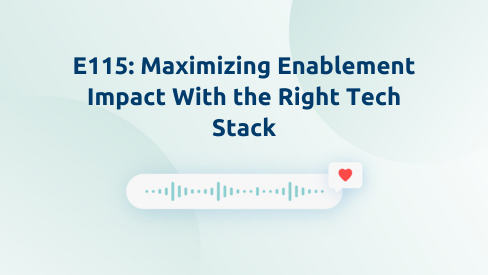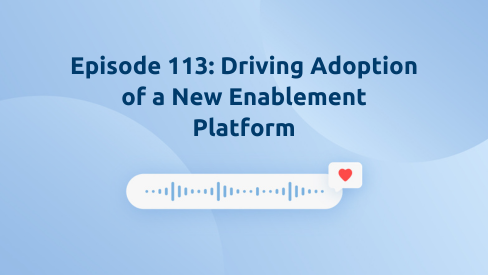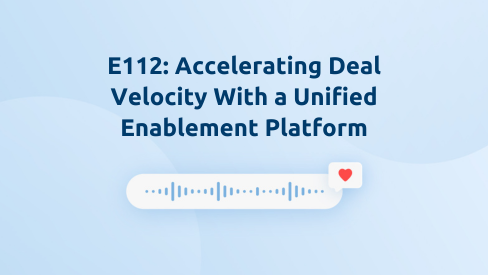A recent survey by Gartner found that 47% of digital workers struggle to find information or data needed to effectively perform their jobs, which can negatively impact rep productivity. So how can you drive sales productivity through enablement?
Shawnna Sumaoang: Hi and welcome to the Win Win Podcast. I’m your host, Shawnna Sumaoang. Join us as we dive into changing trends in the workplace and how to navigate them successfully. Here to discuss this topic is Kara Huff, the senior global marketing manager of services, support & training at Hexagon Asset Lifecycle Intelligence. Thanks for joining, Kara! I’d love for you to tell us about yourself, your background, and your role.
Kara Huff: Thanks so much for having me. I’m the global marketing manager for Hexagon. I’ve been in the marketing industry for 25 years. Throughout product development, portfolio management, and of course, how we enable our sales fields to be successful with our products and solutions.
SS: Thank you so much for joining us, Kara. Now, I’d like to return to that question in the intro. From your perspective, how does enablement help drive sales productivity and what are some of your best practices to do so?
KH: Great question. Sales productivity has changed so much over the past couple of years with all of the different technology that’s out there, and especially with the technology stack that you provide for your field sellers. It’s kind of been a learning game to figure out how we utilize all of those to come together. What we’ve realized is that the more tools that we have that are integrated, that provide a seamless experience for our field sellers, not only helps them to be productive but also helps them on their journey to assist potential customers with their digital transformation. It’s crucial in everything that we do from a Hexagon perspective.
SS: I love that. A key piece of productivity is efficiency. We think about it in terms of efficiency and effectiveness. Prior to implementing Highspot, this was a pain point of yours due to having multiple siloed platforms. Can you tell us more about the efficiency challenges you were facing and how you kind of overcame those with Highspot?
KH: Absolutely. So pre-COVID, we had a lot of different platforms and we’re looking to evolve our technology stack. We had a DAM, so we had a data asset management platform, but we couldn’t see all of the analytics of how content was utilized, and what was hitting all marks with our field sellers. What were our potential customers and existing customers engaging with? We needed something that could give us some analytics and walk us through that buying journey to see what good content looks like and how it’s utilized.
We had over 14,000 pieces of content and when we looked for any CMS and chose Highspot, we were able to narrow that down to about 7,000 assets then over the last couple of years we were able to utilize those analytics to really refine what was good content where we could spend more of our time producing effective pieces of content. Right now we have gone from 14,000 to about 3,500 representing over 78 products and solutions in our portfolio. It’s helped us to become significantly more efficient in our productivity from a marketing perspective.
SS: It sounds like it sounds like you guys were really able to narrow it down to those key pieces of content that resonate with your buyers. Now, your governance strategy clearly has played a key role in helping you improve that efficiency. In fact, I was looking at the stats for your Highspot instance, and you guys are at 55 percent of your content being well governed, which is fantastic. What does your governance strategy look like?
KH: That is also a great question. We worked with our Highspot team to understand exactly what good governance of a CMS looks like, and while 55 percent is great, we would love to increase that to around 70 to 75%. How we’re doing that is we establish a governance guide for our admins of the platform, for our spot owners, so that they can understand exactly what good content looks like. We set up some matrix for them to continuously monitor. We have monthly tasks that they should perform quarterly and yearly. Doing that, allows them to really dive in and do a couple of things, like a content refresh to understand what’s working and what’s not, what’s being utilized, and maybe things that are not getting as much visibility as they would have expected that it would.
It allows them to review things like tagging accessibility or spot location to understand how we can refine it for it to become more effective. It also allows us to really look at the noise. As marketers, sometimes you have stakeholders that think more is better, more content, more explanation. With our analytics going through those as part of our governance strategy allows us to use data to say, hey, this is really what’s resonating and not, and as part of our governance, if we have content that hasn’t been viewed in 90 plus days, then that allows us to do a trigger to say, okay, it’s not working. You either need to retag or reassess the content in it, or we need to archive that so that we can allow valuable content to rise to the surface.
SS: I love that. How has your governance strategy helped you improve sales efficiency? Do you have a few data points you can share?
KH: Yeah, absolutely. Inside of our scorecards that we use for all of our spots, the governance that we have established that says, before when you’ve got a lot of different products and you’ve got a lot of different content types, we thought that it was great to have depth more so than breadth. Our governance strategy has allowed us to look at it to say, that we thought that solution sheets were beneficial for field sellers, but we’ve come to find out that things that we might have just provided as a little cherry on top, if you will, actually resonate more with our field sellers and has higher engagement with our customers. It’s really allowed us to refine that to say, here is what effective content is and where you should be spending your effort first which might take less time to create and implement than what we originally had in our scope.
SS: That’s fantastic. Now, in addition to efficiency, as I mentioned, effectiveness is also a key piece of the productivity formula. One of your big initiatives recently was focused on boosting effectiveness by providing more than 25 plays on your different products. What was the impetus for this initiative?
KH: Sales plays is something that we started going into our second year of having Highspot. We had all the content in there, and we wanted to enable our field to be able to sell it from a systematic approach through content. We set up those sales plays, we did a lot of checks and balances on what good looked like, and then we had a shift in our portfolio of how we were going to position ourselves in the marketplace.
We determined that we needed to have enablement packages geared around those new initiatives. If we had an enablement package, we needed to have a sales play that supported those initiatives. We did an additional 25 sales plays for our sales kickoff that would enable our field to not only hear about the new enablement packages that were developed for them but also to have a sales play around each one of those that included things like what to know, what to say, what to show, and what to pitch.
We provided that consistent approach with a refined asset list for all of those sales plays so that it didn’t matter which approach our field sellers or our account development reps were coming into the process with, they had a consistent method in which to enable themselves. They also share relevant content with our prospects and customers.
SS: I love that. You already touched on a lot of best practices there, but do you have any additional best practices you would share around building effective plays?
KH: Absolutely. It’s great to have a template that just establishes some guardrails. Of course, with all products, you’re going to have a little bit of variance on what’s relative and what’s needed. Sometimes the depth can expand, but by providing a template and saying, hey, guys, here’s the minimum of what you have to have in here, and here is the maximum of what you can have in here, and here is what every play should include. Having pitch templates with pitch styles has been hugely successful for us because ultimately it delivers a plug-and-play method for sales, which is really what they need.
We want them to be able to come in and see the sales play, get the tools that they need to be able to be successful, and then really just have that pitch template that they can use over and over and over again to really gauge the engagement from their prospects.
With all of our sales plays, another requirement that we did is building in the mandatory integration with our Salesforce opportunities. As a filled seller, no matter if they were inside of our Highspot instance, or if they were in GoSell, or if they were in their Outlook or email client, anytime that they were talking around a specific product of interest or solution of interest, that once that was determined, that it automatically populated those plays for them and included those pitch templates so that it created this almost automatic behavior for them to always utilize those plays and always utilize the content in it, which then allowed us to constantly measure the engagement and understand what was winning and hitting and further refine those as, as we go along our process and then building that entire governance. It’s really a full-circle process.
SS: I love that. Now you’ve achieved 71% adoption of your plays, which is also amazing. How do you drive the adoption of your plays?
KH: That’s a great question, and I would love to say that I have the answer to it. It comes with a lot of trial and error. I think that part of the success attributed to the adoption of plays is the confidence that we’ve just put in the platform. It comes with well-governed content. It comes with well-organized content and spots. Knowing that you have got resources that are dedicated to refining it and creating that consistency and collaboration with multiple teams.
We actually have teams that come together and do our plays that span multiple different departments within our organization. We have product owners who are in that process, we have our portfolio strategy and enablement team, our marketing team, and our campaigns team. We have a lot of different key players at the table when we’re developing those plays. Of course, we put them up in that consistent manner, make sure they’re checked off and they meet our standards.
Then, we communicate that to our field sellers to let them know that they’re available to them. After we make sure that it is working with all of the different systems that we have it integrated with, whether it be Salesforce or we utilize Salesloft for our account development team, it’s also integrated there. We get all of that setup and enabled, and then we communicate that in a method to all of the end users for those plays to know that they’re available.
Then we just drive that home with continuing training and awareness of letting them know where they are and having them in the forefront inside of our platform. It’s a lot of different things that we’re trying. We have seen great success and now we just want to continue to refine that process while we continue to update the additional 50-plus sales plays that we already have in our Highspot instance today.
SS: Now, to analyze the impact of plays, because you talked about how important it is to look at how things are performing, I know play scorecards are a key resource for you. What are your best practices for leveraging scorecards to monitor the success of your programs and really optimize the impact?
KH: Scorecards are something that are relatively new for us. They were in beta, I believe, earlier this year while we were working on getting all of our sales plays up and launched. When they started coming out, it was really helping us to understand not just from the analytics. It’s really just like that specific play or that specific spot, what was working and by coming in, it allowed us to look at the scorecards and say, hey, we can look at this by user role, or we can look at this from a content effectiveness perspective, or we can look at this from a pitch engagement perspective. Those are some things that it’s really helped us dive into to understand.
As you had mentioned earlier, our sales play adoption, but also our pitch adoption. By having those scorecards when we set our goals for 2023, we had initially set a 25% increase in pitch adoption, which we thought was a lofty but attainable goal. Yet with those scorecards, we’ve seen 125% pitch adoption. It’s kind of blown our mind a little bit, but the analytics is where it allows us to look at not only what’s working, but also to deliver that data back to our stakeholders that are spending so many resources and time dedicated to developing those plays for them to understand that they’re resonating and that they’re working.
The scorecards, while we do utilize those to help us, we’re just on the tip of the surface on sales plays and being able to refine those and We’re going to utilize some of those metrics and those scorecards to help us define what our 2024 goals are to allow us to dig even deeper into that and increase pitch engagement from an outside perspective.
SS: Impressive pitch stats there, by the way. Kudos to you and the team for that. That’s amazing. Now, Kara, to close, what are some of the key business results that you’ve seen as it relates to sales productivity since implementing Highspot?
KH: There’s been a lot of benefits that we’ve seen, actually. A lot of the points that we’ve talked about today, like providing a single source for our field sellers have been huge. Not only one area that they can come to but one that they know is integrated with our platforms. It’s updated consistently. They know that it’s the latest and greatest content. They know that our biggest initiatives from a sales perspective are at the forefront. They know that we can see how they are engaging with that content or not, which I think plays into the adoption part.
Also, them being able to see the analytics and the engagement behind their pitches to know what’s working and what’s not. I think that it’s important and our initiatives to state while we do have guardrails right inside the platform, here’s all of this different material and different ways that you can utilize it, that we allow them to do it and what works best for them. If that’s a pitch link or an email pitch or a live pitch, or if it’s through Salesforce or their email client, we don’t care how they use the content and how they pitch the content. We just want them to be able to do it where they need it, how they need it, and help them see what productive content and engagement looks like.
They’re our biggest users of the platform, so we use them and their feedback to continuously refine it. That helps us be more successful, and the more that we listen to them and the more we refine it the more confidence they have and everything that’s deployed within our Highspot. As I said, it’s definitely a team initiative and a team goal, and a lot of different contributors to it, but Highspot has allowed us to continuously grow and be successful in that. It’s developed a winning collaboration, so we greatly appreciate our Highspot reps and everything they do to help us be successful.
SS: Well, Kara, thank you. I greatly appreciate you taking the time to do this podcast. Thank you so much for joining us.
KH: Absolutely. Thanks so much, Shawnna.
SS: To our audience, thank you for listening to this episode of the Win Win Podcast. Be sure to tune in next time for more insights on how you can maximize enablement success with Highspot.




